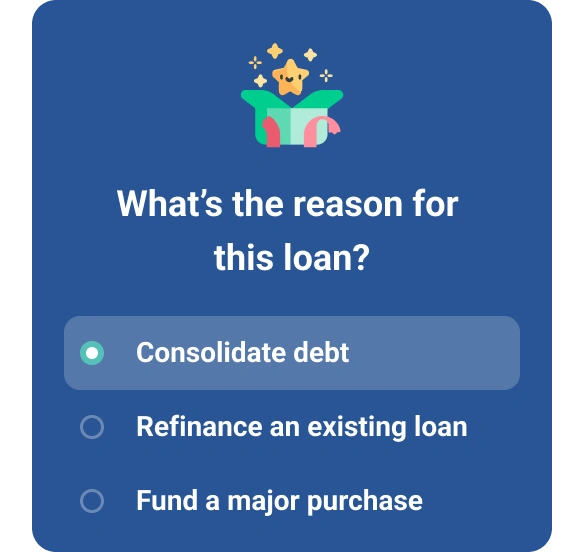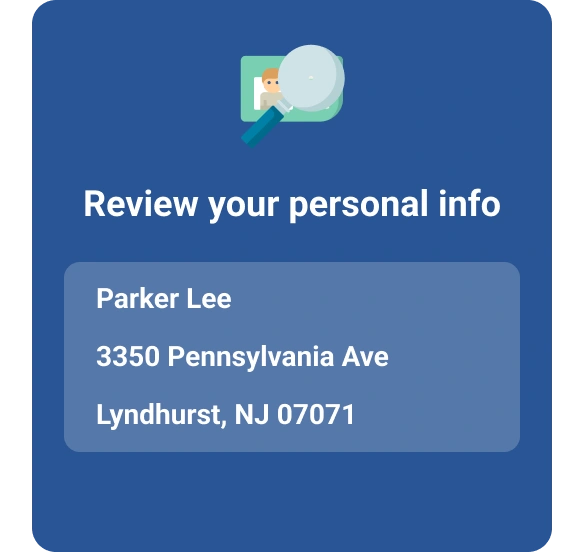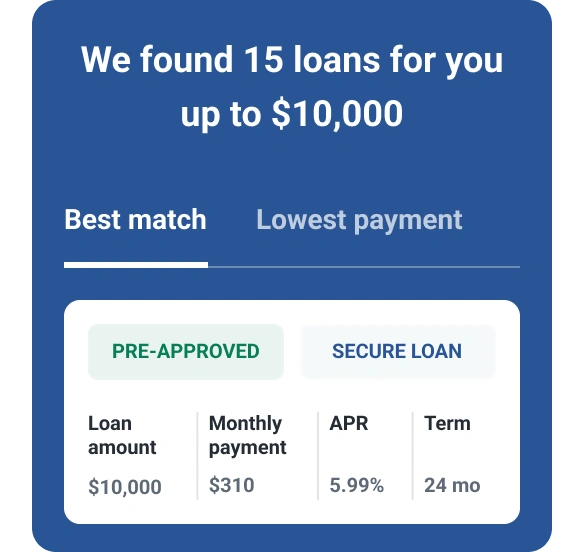How to Compare Personal Loans
Quick Answer
You can compare loans by considering the loan amount, APR, repayment term, fees and other factors. It’s also important to use a loan calculator to estimate your cost of taking out a loan.

Personal loans are a valuable source of quick cash when you want to finance a home renovation, consolidate high-interest debt or cover almost any other financial need. These installment loans are available at most banks and credit unions with rates, terms and conditions that can vary widely from one lender to another.
Comparing loan offers from several lenders to find the best personal loan may save you hundreds or even thousands in interest, fees and other costs. Here's what to consider when comparing personal loan offers from competing lenders.
Types of Personal Loans
There are two types of personal loans, secured and unsecured:
- Secured personal loans require you to provide an asset as collateral to secure the loan. Mortgages and car loans are secured loans backed by the asset you're financing (a house or car in this case). Personal loans can also be secured with assets like cash, stocks, precious metals, insurance policies, savings accounts and other deposit funds. Backing a loan with collateral reduces the lender's risk, which often leads to more flexible eligibility requirements and a lower interest rate compared to unsecured loans.
- Unsecured personal loans don't require any collateral. Without the assurance of collateral, lenders must rely more on your creditworthiness, so you'll typically need a strong payment history and credit score to qualify for the best rates and terms. Unsecured loans usually carry higher interest rates but they may be worth it if you don't have any collateral or don't wish to risk your assets.
How to Compare Loans
You can compare loans by getting prequalified and reviewing the rate, terms and eligibility criteria of each offer. Here's a breakdown of loan features and requirements to consider.
Loan Amounts
Is the loan amount enough to cover your financial need? Some lenders offer personal loans up to $100,000, but remember, you'll pay interest on the amount of your personal loan, so only borrow as much as needed. According to 2023 data from Experian, U.S. consumers had an average personal loan balance of $19,402.
Annual Percentage Rate
A loan's interest rate is the charge for borrowing money, while the annual percentage rate (APR) includes both the interest rate and any additional fees. In other words, the APR includes the total cost of the loan, not just its interest rate. When you compare lender rates on different loans, focus on the APR as it more accurately represents the true cost of borrowing.
Learn more: How Do Personal Loan Interest Rates Work?
Loan Term Length
Repayment terms on personal loans range from a few months to seven years or longer. You may want a longer term to spread out the loan balance and lower your payments. On the other hand, a shorter loan term will help you save money on interest, but your monthly payments will be higher.
Loan Fees
Don't forget about the fees attached to your personal loan offer, including origination fees, prepayment penalties and returned payment fees. Origination fees vary depending on your credit score and loan term but can range from 1% to 8% of the total loan amount. Some lenders don't charge origination fees, which may make their loans more attractive, even if they charge a higher interest rate. As mentioned, pay close attention to APRs when comparing loans, as fees are included in your APR.
Fixed or Variable Rate
Most personal loans come with fixed interest rates, which means your rate and monthly payments remain the same for the life of the loan. This can make your loan easier to manage and helpful for consolidating debt. Some lenders offer variable-rate personal loans, which could provide a lower interest rate and save you money if the interest rate holds steady or declines. However, if interest rates climb, your payments could also rise and become harder to manage.
Personal Loan Calculator
Before applying for a personal loan, it's imperative to understand how it will impact your monthly budget. A personal loan calculator can help you break down the costs you'll pay on a particular loan to help you determine its affordability.
Learn more: Common Personal Loan Terms You Should Know
Personal loan calculator
For example, let's say you receive a quote for a $10,000, two-year loan at 12% with no origination fee. When you plug these numbers into a personal loan calculator, you'll discover your monthly loan payments are estimated to be $470.72 for 24 months. During that time, you'll pay $1,297.63 in interest, which means your $10,000 loan will cost $11,297.63 by the time you reach your payoff date. This is likely less than you'd pay with other borrowing options, such as credit cards, which can have APRs approaching 30%.
If you haven't started getting quotes, enter the loan amount and term you want into the calculator. For the interest rate, you can use various rates to estimate a range of interest rates you might receive. The latest data from the Federal Reserve shows that the average interest rate on a two-year personal loan is about 12%, and that might serve as a good starting point for your comparisons. Bear in mind you may receive a higher or lower interest rate depending on your credit, debt-to-income ratio and other factors.
Personal Loan Pros and Cons
A personal loan can give you the funds you need at competitive rates, but the added debt is a downside you must consider.
Pros
- Competitive rates: Personal loans typically have lower rates than credit cards and other forms of credit.
- Flexible borrowing amounts: Personal loan amounts can vary from a few thousand dollars to $100,000.
- Predictable payments: Most personal loans have fixed interest rates, so your payment amount remains the same throughout your term.
- Flexible repayment terms: Personal loan terms range from two to five years, helping you dial in the right balance of affordable payment and total interest paid.
Cons
- Fees and penalties: These costs could include application and origination fees from 1% to 8% of your loan amount. Loans could also include a prepayment penalty if you zero out your balance early.
- More debt: Taking out a personal loan adds to your debt load and could leave you with less money to work with each month.
- Higher interest rates: While average personal loan rates are generally lower than certain other credit types, they range from 6% to 36%, so you could end up paying more depending on your creditworthiness.
- Potential credit score harm if you miss payments: Missing personal loan payments could harm your credit. Payments that are more than 30 days past due are typically reported to the consumer credit bureaus, resulting in credit score harm.
Steps to Take Before You Get a Personal Loan
Getting a personal loan is a fairly straightforward process. In most cases, you must apply online or in person at a local bank branch, submit supporting documents your lender requests and wait for an approval decision.
However, a little prep work before you submit a loan application could help you improve your odds of approval and receiving favorable terms. Here are the important steps to take before applying for a personal loan:
1. Check Your Credit
Checking your credit score before applying for a loan can help you avoid wasted time applying with lenders whose qualifications you don't meet. You'll usually need good credit to qualify, typically a 670 or better FICO® ScoreΘ, the credit score used by 90% of top lenders. However, some lenders have less stringent requirements and work with borrowers with bad credit.
Get a clearer picture of your credit by accessing your credit report from all three credit bureaus (Experian, TransUnion and Equifax) at AnnualCreditReport.com. You can also check your credit report and score for free with Experian anytime. Review your credit report for any inaccuracies that may be bringing down your score. Remember, you have the right to dispute information on your credit report. Address any issues you find and consider taking steps to improve your credit score before applying.
2. Determine How Much You Need
Calculating the loan amount you'll need can help you identify the best lenders to consider. After all, there's no sense applying with a lender if their maximum loan amount falls short of your needs. Aim to borrow only what you need since you'll pay interest on every dollar you borrow.
3. Evaluate Your Budget
Review your monthly income and expenses to help determine how much you can reasonably afford to pay each month on a new personal loan. As demonstrated above, utilize a personal loan calculator to estimate your monthly payment and make sure it fits comfortably within your monthly budget. Review your expenses to spot opportunities to free up cash to add to your payments and pay off your loan sooner.
4. Compare Secured and Unsecured Loans
Although most personal loans are unsecured, some lenders may require you to secure your personal loan with collateral. Before applying, consider the trade-offs with secured and unsecured loans and decide which one best suits your needs. Remember, secured loans may offer lower interest rates, but there's always a risk of losing your collateral if you default. On the other hand, an unsecured loan doesn't require you to put up any assets as collateral, but you might pay a higher interest rate.
5. Prequalify and Compare Offers
Before formally applying for a loan, get prequalified with several lenders and compare offers. Prequalifying allows you to check lender rates with a soft credit inquiry that won't hurt your credit score.
Once you receive some offers, compare their APRs, repayment terms, fees and penalties to identify the best personal loan for you. If you need the money urgently, look for information on funding times. Most personal loans are funded within a few business days, but some provide next-day or even same-day funding.
Once you choose a lender, you can formally apply and may receive your approval decisions immediately, though some lenders may need several days to review your financials.
Get Matched With Loan Offers Based on Your Credit Profile
The advantage of getting multiple loan offers is that you can review estimated APRs, terms and loan amounts from each lender without impacting your credit. So, if you're not approved, you don't have to formally submit an application and risk a new hard inquiry, which can temporarily ding your credit score, usually by five points or less.
If you want to compare loans with multiple lenders, you can use your Experian account to get matched with several loan offers based on your credit. That way you can review several options side by side from lenders with a higher likelihood of approving your personal loan.
Need a loan?
Whether you're shopping for a car or facing a last-minute expense, compare loan offers matched to your credit profile.
Start now for freeAbout the author
Tim Maxwell is a former television news journalist turned personal finance writer and credit card expert with over two decades of media experience. His work has been published in Bankrate, Fox Business, Washington Post, USA Today, The Balance, MarketWatch and others. He is also the founder of the personal finance website Incomist.
Read more from Tim

